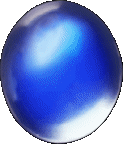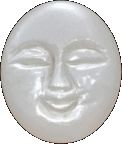| |
Moonstone
|
Moonstone is an opalescent orthoclase, and the white variety of this gem closely resembles its celestial namesake. The gems folkloric connection to the moon so significant that many of the early lapidaries claim the stone was solidified moonlight and will actually wax and wane with the moon. In addition to the most commonly encountered white variety, moonstone also occurs in gray, yellow, red, and in rare instances, green or blue. The stone that is marketed as "rainbow moonstone" is in fact not a true moonstone at all, but a rather variety of labadorite.
Most of the entries in early lapidaries debate the physical nature of the moonstone, rather than its folklore. The entries concerning the moonstone often conflate it with other gemstones such as our modern sunstone, tigereye, or chrysoberyl. In one instance an existing artifact initially identified as being set with a moonstone in one of the historical lapidaries turned out to be a heavily included rutilated quartz.
The moonstone is considered a stone of lovers and an idea material to use in betrothal tokens. Such a gift would increase love and allow the couple to see their future if held in the mouth at the proper time and day of the month. This specific time varies, of course, depending on the lapidary.
The stone’s association with the moon made it popular with magicians, and other magical practitioners that could afford it. It was sought after by thieves who believed the stone would render them invisible, and make the law overlook them. Sailors would journey with a moonstone to protect them from bad weather. And a moonstone amulet was supposed to be especially beneficial for a woman seeking to get pregnant and carry to term, where it would allow an “easy birth”.
|
Colors
|
White, gray, yellow, red, green, or blue
|
Locations
|
Russia, Brazil, Germany, India, Madagascar, Uruguay and the USA
|
Compisition
|
KAlSi3O8, Potassium Aluminium Silicate
|
Hardness
|
6 - 6.5
|
|

|

|

|
|
|
|
|
|